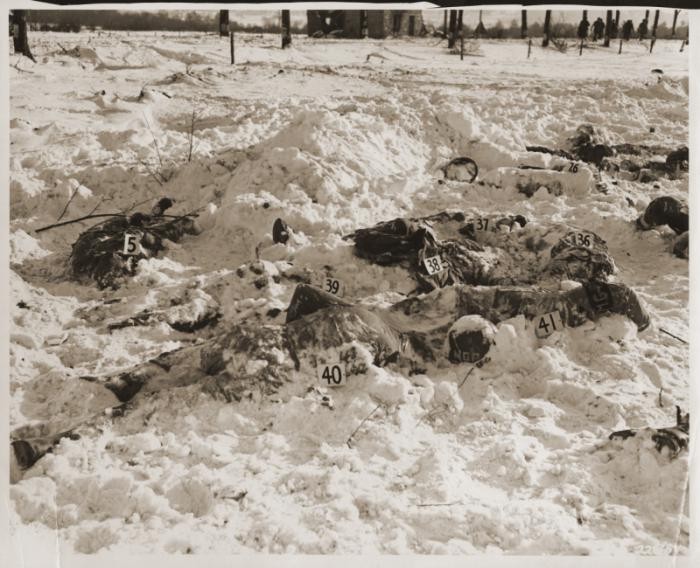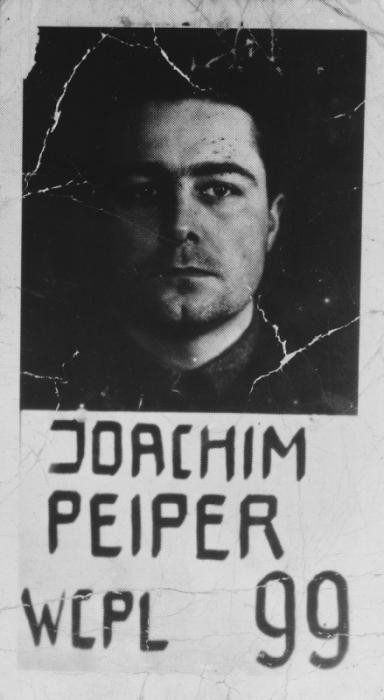
The Malmedy Massacre
Background
On December 16, 1944, the German military launched the “Battle of the Bulge.” It was a last-ditch German military counter-offensive against the Allied armies in the West. Hitler hoped that the German counter-attack would split the British and American armies, allow his forces to capture the port city of Antwerp, and ultimately stall the Allied offensive against Germany.
On the day after the German offensive began, Waffen SS units captured and murdered more than 80 US soldiers and Belgian prisoners. This atrocity is known as the “Malmedy Massacre.”
The Massacre
On December 17, 1944, the 1st SS Panzer Division of the Sixth Panzer Army, commanded by Colonel Joachim (Jochen) Peiper, was heading west from Büllingen, Belgium. This movement was part of the general German advance during the Battle of the Bulge. At the same time, a US convoy of thirty vehicles and nearly 140 men of Battery B of the 285th Field Artillery Observation Battalion was heading south from Hürtgen Forest toward Ligneuville.
The two forces converged just before noon at the crossroads hamlet of Baugnez, two and a half miles south of Malmedy. Combat Group Peiper (Kampfgruppe Peiper) (part of the Waffen SS) immediately began firing upon Battery B. The US troops panicked. Those who did not escape, including medical personnel, quickly surrendered. After being searched and relieved of their personal possessions, the US troops were lined up in eight rows in a field at the crossroads. Then for reasons that are unclear, Combat Group Peiper fired on the GIs. German troops walked among the bodies and shot any who appeared to be alive. Survivors of the atrocity recalled being fired upon several times, and even hearing laughter as the Waffen SS troops killed the Americans.
When the Germans left the site, at least 84 US soldiers were dead. Just over 40 Americans survived the incident, now known as the Malmedy Massacre, either by fleeing into the woods or pretending to be dead.
The Malmedy Massacre was one of a series of atrocities committed by Peiper’s division. US prosecutors claimed officials believed that his unit was responsible for killing some 350 unarmed American soldiers and about 100 Belgian civilians over a one-month period in Belgium as well as other atrocities on the eastern front.
The discovery of the SS crime led to a concerted manhunt by US military authorities to locate and prosecute the killers. After the war, they succeeded in tracking down some 400 members of the Waffen SS unit, who were taken to a prison in Schwäbisch Hall, near the German city of Stuttgart. From December 1945 to April 1946, US Army war crimes investigators interrogated the prisoners to gather evidence and confessions. Subsequently 74 of the SS men were selected to stand trial for the Malmedy massacre and the killings of non-combatant Belgian civilians. The US Army then transported them to the former Dachau concentration camp, where US military tribunals were holding war crimes trials.
Trial

On May 16, 1946, the trial of 74 SS members who had taken part in the Malmedy massacre and other killings during the Battle of the Bulge began. All of the defendants were charged with violation of the laws and usages of war and with deliberately participating in the killing, shooting, and torturing of US soldiers and unarmed civilians. The prosecution argued that the defendants committed these war crimes as part of premeditated Nazi conspiracy to wage a ruthless campaign against Allied forces and civilians during the German military offensive of December 1944. This policy of killing prisoners of war, it was charged, had been ordered by Hitler and willingly executed by Peiper.
The defense counsel did not dispute the fact that US Army soldiers had been killed, but argued that the shootings occurred in the heat of battle, not as a result of a criminal conspiracy.
On July 16, the military tribunal found all the defendants guilty; forty-three were sentenced to death by hanging (including Peiper) and twenty-three were sentenced to life in prison, with the rest receiving either ten, fifteen, or twenty year prison terms.
Controversies
During the course of the proceedings, Peiper claimed that the American war crimes investigators had beaten the defendants, coerced them into signing confessions, given them mock trials, and intimidated their families. These accusations, which became the subject of heated dispute, haunted the trial. The chief American defense counsel, Colonel Willis M. Everett, appealed to the US Supreme Court as well as other bodies to have the executions halted and the matter of “fraudulently-acquired confessions” and other legal improprieties thoroughly investigated.
News of the defense claims leaked out to the press and generated criticism of American war crimes trial procedures both in the United States and Germany. Leading German clerics, including some who had been imprisoned by the Nazis in concentration camps, condemned the Malmedy proceedings. The United States Congress also launched investigations into the claims raised by the defense team, but the findings largely exonerated American authorities in Germany. Under popular pressure in the midst of the Cold War between the western powers and the Soviet Union, all the sentences of the Malmedy defendants were commuted, including those sentenced to death. By 1956 all of the convicted had been freed from prison.

